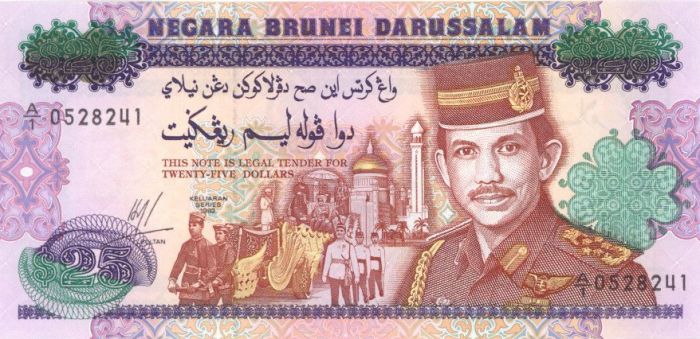Brunei - P-21 - Brunei Ringgit - Foreign Paper Money
Inv# FM2330 Foreign Paper Money
25 Ringgit (25 Dollars), P-21. Very colorful note! 25th anniversary of the Accession to the throne!
The Brunei dollar (Malay: ringgit Brunei, currency code: BND), has been the currency of the Sultanate of Brunei since 1967. It is normally abbreviated with the dollar sign $, or alternatively B$ to distinguish it from other dollar-denominated currencies. It is divided into 100 sen (Malay) or cents (English). The Brunei dollar is issued by the Autoriti Monetari Brunei Darussalam (Monetary Authority of Brunei Darussalam).
Under a Currency Interchangeability Agreement in 1967, the Brunei dollar is interchangeable with the Singapore dollar at par. As such, the Brunei dollar is accepted in Singapore as "customary tender"; likewise, the Singapore dollar is accepted in Brunei.
Early currency in Brunei included cowrie shells. Brunei is also famous for its bronze teapots, which were used as currency in barter trade along the coast of northern Borneo. The Spanish-American silver dollar brought over by the Manila galleons was in wide use for Brunei's international trade from the 16th to 19th centuries; the 19th century Straits dollar was itself derived from the same coin.
Brunei issued tin coins denominated in pitis in AH1285 (AD1868). These were followed by a one cent coin in AH1304 (AD1888). This cent was one hundredth of a Straits dollar.
As a protectorate of Britain in the early 20th century, Brunei used the Straits dollar from 1906, the Malayan dollar from 1939 and the Malaya and British Borneo dollar from 1953 until 1967, when it began issuing its own currency.
The Brunei dollar replaced the Malaya and British Borneo dollar in 1967 after the formation of Malaysia and the independence of Singapore. Until 23 June 1973, the Malaysian ringgit was exchangeable at par with the Singapore dollar and Brunei dollar. The Monetary Authority of Singapore and the Brunei Currency and Monetary Board (now the Authoriti Monetari Brunei Darussalam (Monetary Authority of Brunei Darussalam) still maintain the exchangeability of their two currencies. The dollar is accepted as "customary tender" in Singapore according to the Currency Interchangeability Agreement, although it is not legal tender there.
Coins were used in Brunei from the 10th century. The Straits dollar was also used in Brunei from 1906.
Due to the close ties between China and Brunei, the first type of coins used in Brunei were Chinese coins. This was initially called ‘Pitis’. They were later known as ‘Kue’ when local ‘Pitis’ were introduced. The local ‘Pitis’ coins had ‘Sultanate of Brunei’ stamped in front of the coin and the royal umbrella was imprinted at the back. These were issued from the 16th to the 19th century. Previous Islamic coins were also called the ‘Pitis’. Another type of coin that was used in Brunei were ‘Duit besi’ (which roughly translates to ‘Iron money’). Iron was considered valuable those days that it was used as money. 100 one-square inch pieces were valued at 1 dollar.
The last coin to be issued before the introduction of the Straits Settlements currency was the ‘Duit Bintang’, otherwise known as the ‘Star coin’ or the 'Star Cent'. It is called the Star coin because of the star imprinted on the obverse of the coin. It was minted in Birmingham, England, in 1887. It was made from copper.
With the introduction of the Straits Settlements currency, the previously used coins were taken out of circulation. They were, however still used with certain exchange rates.
The Straits dollar was introduced in Brunei in 1906. It was later replaced by the Malayan dollar which was introduced to British colonies and Brunei in 1939. It replaced the Straits dollar at par with a 1:1 exchange rate. The Malayan dollar was issued by the Board of Commissioners of Currency in Malaya. The board stopped issuing the Malayan dollar during the Japanese invasion during World War II. The Malayan dollar had the portrait of King George VI in front of the note.
In 1952, the board was renamed the Board of Commissioners of Malaya and British Borneo. The board then began to issue notes to Malaya, Singapore, Sarawak, British North Borneo, and Brunei in 1953. This was known as the Malaya and British Borneo dollar. In 1967, the Malaya and British Borneo dollar was replaced by three new currencies: the Malaysian dollar, Singapore dollar and the Brunei dollar, all at par.
The Singapore dollar is still interchangeable with the Brunei dollar today.










Ebay ID: labarre_galleries